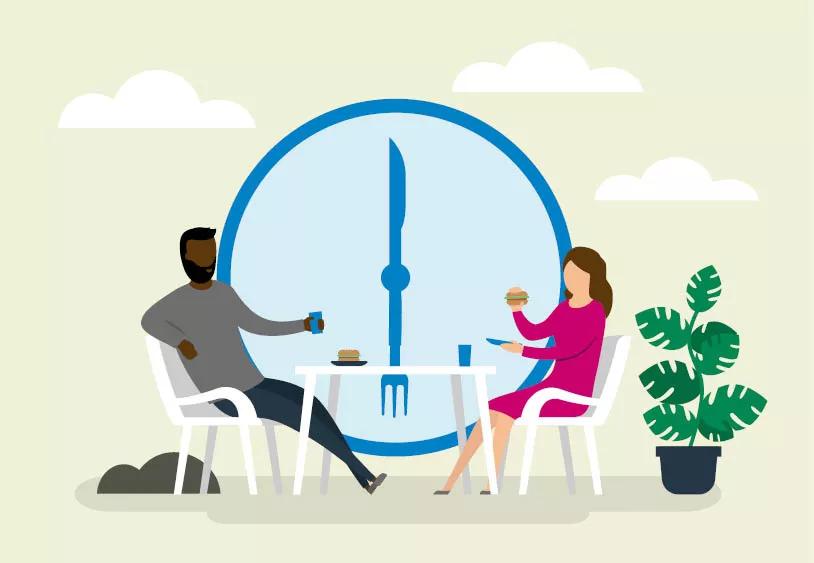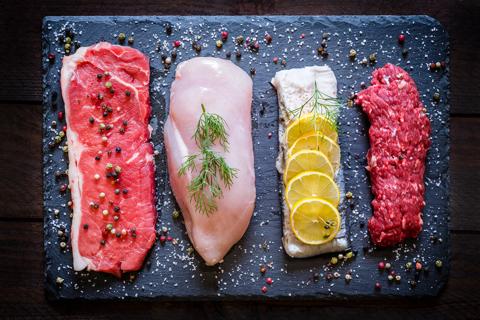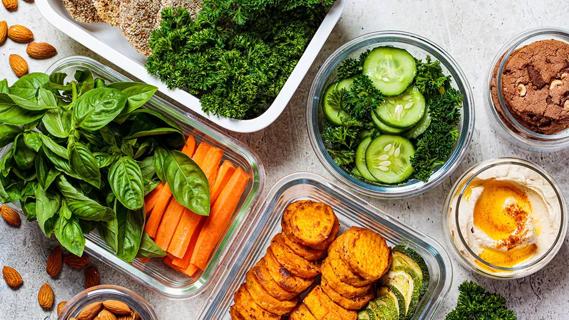A study shows that eating a late dinner can increase your chance of having obesity

You’ve heard the saying: “You are what you eat.” But what about when you eat?
Advertisement
Cleveland Clinic is a non-profit academic medical center. Advertising on our site helps support our mission. We do not endorse non-Cleveland Clinic products or services. Policy
Your schedule is jam-packed with school drop-off, work meetings, after-school activities and everything in between, making it hard to sit down to a meal consistently day after day.
Does the time of day that you eat meals factor into your overall health and wellness? And if so, what’s the best time to eat dinner? What about breakfast and lunch?
“Our schedules make it challenging to eat dinner at a reasonable time,” recognizes registered dietitian Julia Zumpano, RD, LD. “And it’s leaving us scrambling for what to eat and what we can grab on the go. In some cases, it can lead to disordered eating patterns.”
Zumpano provides us with some guidance on the best time to eat dinner and other meals throughout your day.
Zumpano says it’s a personal decision that depends on any medical conditions you might have, as well as your health and wellness goals.
A 2016 study shows that our eating patterns are varied and erratic. While you may like to have dinner on the table at 6 p.m., others may be eating a later supper or snack before bed.
Even if you have a habit of eating three square meals a day, a change can be enough to throw off your eating habits. For example, your kids could have a choir performance smack dab in the middle of dinner time or you’re behind at work and skip lunch, which may lead to you making unhealthy food choices later in the day (raise your hand if you’re guilty of a fast-food dinner run).
Advertisement
In fact, a 2022 study shows eating later in the day increases your risk for having obesity.
“The later we eat, the hungrier we get, which can often lead to quick and unhealthy meal options,” notes Zumpano. “If we plan ahead, we can have a healthy dinner ready or at least thought through an on-the-go meal, meaning that you made time to stop at the salad bar instead of the drive-thru.”
But if you’re looking for some guidance on when to eat throughout the day, Zumpano offers the following recommendations:
Not everyone is a breakfast person — and that’s OK. But if you do eat a morning meal, Zumpano suggests eating breakfast with the first hour to hour-and-a-half after you wake up.
And what type of breakfast should you eat? We think you know the answer (sorry, chocolate croissant). But it bears repeating.
“I recommend eating a protein-based breakfast. I’m a fan of egg whites with a turkey sausage or chicken sausage. I love cottage cheese or Greek yogurt for breakfast. I think they’re great sources of protein. Scrambled tofu is a great plant-based breakfast option,” advises Zumpano.
“Include fiber rich foods to your meal. So, if you’re going to have eggs, throw in some greens, sauteed veggies, black beans or salsa. If you’re going to have cottage cheese or Greek yogurt have some berries and nuts with it.”
She also stresses limiting or avoiding added sugars because they can lead to a spike in your blood sugar, then a drop, which causes you to search for more sugar for energy. Sugar is addictive for most people — if you start your day off with something sweet, you’ll fight that sugar craving all day long.
A good rule of thumb that Zumpano likes to follow is to space your meals four to six hours apart.
And like breakfast, you want to focus on having a meal that mainly consists of fiber and protein. Think about a salad with grilled chicken and chickpeas or a hearty bowl of bean and vegetable soup with turkey meatballs. A whole-grain wrap, filled with cabbage slaw, avocado, edamame beans and tuna, is also a great option.
“A lunch filled with protein and fiber can help you over the 2 or 3 o’clock hump where energy levels tend to plummet,” says Zumpano. “If your meal is too high in carbohydrates, fat or sugar, that can leave you feeling sluggish.”
She adds that it’s more important to focus on what’s in your meal rather than when you’re eating your meal. In fact, she likes to have a larger lunch, rather than a bigger dinner.
“Some European countries focus on having a larger lunch and then a lighter dinner,” she shares. “European countries tend to have a lower incidence of disease and obesity when compared to Americans.”
Advertisement
To snack or not to snack? You’re feeling hungry and all you want to eat are some potato chips or a candy bar to tide you over until your next meal. So, what do you do?
“Snacking is often unnecessary if you are eating enough at meals times,” says Zumpano. “But if you had a lighter meal, skipped a meal or didn’t have time to finish your meal, healthy snacks can help prevent overeating at the next meal for some people. Mindless snacking lead by cravings of salty or sweet often results in high amounts extra calories in the form of processed food.”
So, if you’re going to snack, snack smartly. Opt for a piece of fruit with a handful of nuts. And before you eat, Zumpano says to pay attention to your hunger cues. Are you snacking out of boredom? Or because you want a distraction from work?
If you determine you’re truly hungry, then have a healthy snack.
While it can be hard to fit into your schedule, there’s something to be said about eating dinner earlier in the evening — at least three hours before your bedtime.
“An earlier dinner gives you a good amount of time to digest your food and allows your blood sugar to properly rise and fall after dinner,” Zumpano explains. “So, you’re not going to bed with a full belly or skyrocketing blood sugar. In fact, people who eat an earlier dinner often report better sleep.”
Advertisement
But she adds that if you must have a late dinner, there’s no need to stress.
“If you have to eat dinner later than you’d like, don’t be overly concerned with the timing,” she continues. “In that case, you want to make better choices on what you eat. And if you’re consistently going to eat late dinners, then consider making your lunch your largest meal that can carry you through to dinner. Then, choose a lighter dinner so you’re not overconsuming calories.”
Need a light dinner suggestion? Try a green salad with grilled fish, vegetable bean stew with lean meat, or a shrimp and veggie stir-fry. Pro tip? Stick to protein and vegetables, and keep it light in starch and fat especially when it’s getting close to bedtime.
Another tip if you’re eating dinner later? Get moving to help speed up digestion.
“If you’re eating dinner and going straight to bed, that’s going to slow down the digestion process,” states Zumpano. “If you take a short 10- to 20-minute walk or do something active like clean the kitchen, vacuum or mop, or any moderate amount of movement is going to help with digestion.”
You’ve probably heard of intermittent fasting or time-restricted eating. But how does it work?
“Time-restricted eating is when you shorten your eating window to anywhere between eight and 12 hours, meaning you’re only eating between eight and 12 hours for that day,” clarifies Zumpano. “And the rest of the time, you’re fasting from any food or beverage that has calories.”
Advertisement
So, should you try time-restricted eating? It depends on the person.
“If you’re interested in time-restricted eating, start with a 12-hour fast after dinner, so if you’re done with dinner by 7 p.m., avoid eating or drinking until 7 a.m. the next day. If that’s no big deal, begin to push breakfast an hour later until you find the eating window that works best for your body and schedule,” suggests Zumpano. “It’s important to give your body rest from eating but the food you choose to eat can play an even greater role in health.”
When it comes to when and how you eat your meals throughout the day, there isn’t a one-size-fits-all approach.
“It really should be tailored and personalized to you,” Zumpano emphasizes. “The No. 1 thing you want to keep in mind is what you’re eating: Are you consuming enough protein and fiber at your meals? Are you snacking on whole foods? But the timing of those meals can vary based on you and your schedule.”
Learn more about our editorial process.
Advertisement

With a focus on internal cues for hunger and fullness, this eating style may revolutionize your relationship with food

Review the ingredients, watch for sugar and fat, and choose one with the right amount of protein for your needs

A typical recommended balanced diet is half fruits and veggies, a quarter protein and a quarter grains

Foods high in protein, fiber and water can help keep hunger at bay

This quirky food trend is harmless, as long as you’re getting enough protein, fiber and healthy fats

This vital nutrient helps your brain and body in many ways — and most of us need more of it

Wrapped or sandwiched, try to choose fillings and condiments that are minimally processed, low in saturated fat and high in fiber

Set yourself up for success by carefully choosing your recipes, storage containers and prepping day

Babies can get congested easily, but you can calm their cough by keeping them hydrated, using nasal drops and running a humidifier

Weight loss may cause loose, sagging skin and muscle loss to your rear

Several conditions, like vitiligo and fungal infection, can cause a loss of pigmentation, leading to white spots or patches on your skin